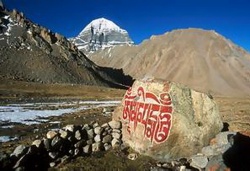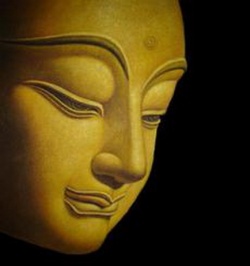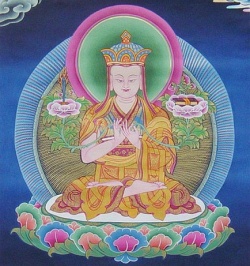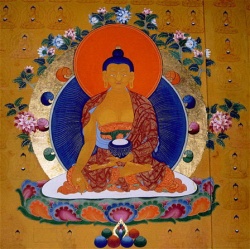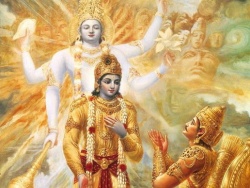The Tibetan Canon
The Tibetan Buddhist canonis a loosely defined list of sacred texts recognized by various sects of Tibetan Buddhism.
In addition to earlier foundational Buddhist texts from early Buddhist schools, mostly the Sarvastivada, and mahayana texts, the Tibetan canon includes Tantric texts.
The Tibetan Canon underwent a final compilation in 14th Century by Bu-ston (1290-1364). The Tibetans did not have a formally arranged Mahayana canon and so devised their own scheme which divided texts into two broad categories:
#Kanjur (bka' 'gyur) or "Translated Words", consists of works supposed to have been said by the Buddha himself. All texts presumably have a sanskrit original, although in many cases the Tibetan text was translated from Chinese or other languags.
- Tanjur (bstan 'gyur) or "Translated Treatises" is the section to which were assigned commentaries, treatises and abhidharma works (both Mahayana and non-Mahayana). The Tanjur contains 3626 texts in 224 Volumes.
The bka' 'gyur is divided into sections on Vinaya, Perfection of Wisdom Sutras, other sutras (75% Mahayana, 25% Early Wisdom Schools aka Hinayana), and tantras. When exactly the term bka' 'gyur was first used is not known. Collections of canonical Buddhist texts existed already in the time of Khri srong ide rtsan, the sixth king of Tubo.
The exact number of texts in the bka' 'gyur is not fixed, each editor takes responsibility for removing texts he considers spurious, and adding new translations. Currently there are about 12 available bka' 'gyur. These include the Derge, Lhasa, Narthang, Cone, Peking, Ugra, Phudrak, and Stog Palace versions, each named after the physical location of its printing. In addition some canonical texts have been found in Tabo and Dunhuang which provide earlier exemplars to texts found in the bka' 'gyur. All extant bka' 'gyurs appear to stem from the Old Narthang bka' 'gyur. The stemma of the bka' 'gyur have been well researched in particular by Helmut Eimer.
== Exoteric tradition ==
In the Tibetan tradition, some collections of teachings and practices are held in greater secrecy than others. The sutra tradition is comprised of works said to be derived from the public teachings of the Buddha, and is taught widely and publicly. The esoteric tradition of tantra (below) is generally only shared in more intimate settings with those students who the teacher feels have the capacity to utilize it well.
=== Important Indian scholars ===
==== Two Supremes ====
Two Indian Buddhist scholars are widely considered to be of paramount importance by Tibetan Buddhists. As such, they are referred to as the Two Supremes.
- Asanga founder of the Yogachara school
- Nagarjuna founder of the Madhyamika school
==== Six Scholarly Ornaments ====
These scholars's works are of secondary importance to the Tibetan Buddhist canon. As the ranking of their importance is not as universally recognized, there are occasionally substitutions made in this list.
- Aryadeva foremost disciple of Nagarjuna, continued the philosophical school of Madhyamika
- Dharmakirti famed logician, author of the Seven Treatises; student of Dignana's student Ishvarasena; said to have debated famed Hindu scholar Shankara
- Dignana famed logician
- Gunaprabha foremost student of Vasubandhu, known for his work the Vinayasutra
- Sakyaprabha prominent expositor of the Vinaya
- Vasubandhu author of the Abhidharmakosha
==== Seventeen Great Panditas ====
The Kangyur ("Translation of the Buddha's Word")—the texts that are attributed to the Buddha. Esteemed and worshipped for centuries in Tibet, it is regarded as the single most authoritative repository of Buddhist thought by Tibetan speakers throughout Asia and beyond. The Kangyur unquestionably ranks among the most important sources for the study of Buddhism in India and Tibet. Containing many hundreds of Buddhist texts translated in the eighth and ninth centuries by teams of scholars from India, China, Tibet and Central Asia in order to create the literary foundation for Buddhism in Tibet, it is unrivalled in doctrinal authority and historical value. On account of its vast scope and the reliability of its translations, the Kangyur is widely used as a principle point of access to centuries of Buddhist developments in the Indo-Tibetan cultural world.
As a Mahayana tradition, Tibetan Buddhism's Kangyur includes most of the Mahayana sutras. In addition it includes tantric (esoteric) texts.
The Tengyur ("Translations of treatises")—traditional commentaries attributed to subsequent learned and realized masters of Buddhism. In the Tibetan tradition, it is common for a meditation master to offer explanations and interpretations, sharing his understanding with students and shedding light on centuries-old texts that may be difficult for contemporary practitioners to fully understand.
There are a number of popular Tibetan editions of these scriptures.
The Tibetan Canon which consists of two parts:
(1) the bKángjur ("Translation of the Word of the Buddha"), pronounced Kanjur, and
(2) the bStan-'gyur ("Translations of the Teachings") pronounced Tanjur.
Because this latter collection contains works attributed to individuals other than the Buddha, it is considered only semi-canonical. The first printing of the Kanjur occurred not in Tibet, but in China (Beijing), being completed in 1411. The first Tibetan edition of the canon was at sNar-tang with the Kanjur appearing in 1731, followed by the Tanjur in 1742. Other famous editions of the canon were printed at Derge and Co-ne.
(a) bKángjur (Kanjur): Translation of the Word of the Buddha; 98 Volumes (according to the Narthang edition).
Vinaya: 13 Volumes.
Prajnaparamita: 21 Volumes.
Avatamsaka: 6 Volumes.
Ratnakuta: 6 Volumes.
Sutra: 30 Volumes. 270 texts, 75% of which are Mahayana, 25% Hinayana (prominence and precedence being invariably given to Mahayana sutras).
Tantra: 22 Volumes. Contains more than 300 texts.
The second, the Tanjur (bStan-'gyur) is a supplement to the former, or in other words, continuation of the tradition of the Kanjur. Among its contents are a collection of stories, the commentaries on the Tantra section of the Kanjur and the commentaries on the sutra section. There are also works relating to Abhidharma and Vinaya as well as Madhyamika and Vijnanavada. Works coming under the sutra section of the Tanjur are not necessarily commentaries on the texts contained in the Mdo-section of the Kanjur. They are believed to be authoritative works, some of which, however, are not even Buddhist in character. They deal with logic, grammar, lexicography, poetry and drama, medicine and chemistry, astrology and divination, painting and biographies of saints. Their inclusion in this part of the Tibetan Canon is perhaps justified on the acceptance of the position that they are necessary aids and accompaniments in the practice of the religion.
(b) bStan-'gyur (Tanjur): Translations of the Teachings 224 Volumes (3626 texts) according to the Beijing edition.
A. Sutras ("Hymns of Praise"): 1 Volume; 64 texts.
B. Commentaries on the Tantras: 86 Volumes; 3055 texts.
C. Commentaries on Sutras; 137 Volumes; 567 texts.
Prajnaparamita Commentaries, 16 Volumes.
Madhyamika Treatises, 29 Volumes.
Yogacara Treatises, 29 Volumes.
Abhidharma, 8 Volumes.
Miscellaneous Texts, 4 Volumes.
Vinaya Commentaries, 16 Volumes.
Tales and Dramas, 4 Volumes.
Technical Treatises, 43 Volumes.
